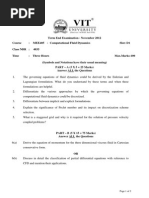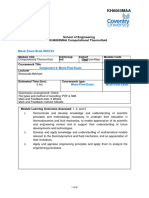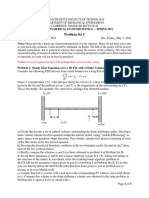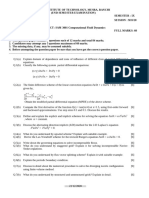Computer Project
Uploaded by
lepharm1998Computer Project
Uploaded by
lepharm1998ME618-ST: High Performance Computing and
Bio-Inspired Computational Fluid Dynamics
Fall 2024
Computer Project 2
Due 11/11/24
You must email me your project by the end of the day (11:59PM) on 11/11/24.
My email is peter.balogh@njit.edu
Specifically, email me a .zip file which contains:
• A .pdf file describing your answers to the questions, any plots of your results,
discussion, etc. You can use any text editor (i.e. Word, Latex, etc.) to detail any
equations, discretizations, etc. you need to work out. Alternatively, if you prefer
to work things out on paper, you can just take a picture of each page and load
that into the pdf.
• All computer code files. I do not want screenshots of your code, or your code
copy and pasted into a word document. I want the actual computer code files
you have made (i.e. your .f or .f90 files if you use fortran, your .m files if you use
matlab, etc.)
• Anything else you want to submit for a thorough project submission.
ME618-ST: High Performance Computing and
Bio-Inspired Computational Fluid Dynamics
Fall 2024
We wish to study the transient diQusion of a drug concentration (𝐶) into tissue in 2D.
Consider the following transient diQusion equation:
𝜕𝐶 𝜕!𝐶 𝜕!𝐶
= 𝛼 & ! + !*
𝜕𝑡 𝜕𝑥 𝜕𝑦
in the square domain (1 x 1) as shown below, with initial condition 𝐶(𝑥, 𝑦, 𝑡 = 0), 𝛼 = 1, and
boundary conditions also as shown below.
y
Ctop = 1
C(x,y,t)
Cleft = 0 1
Cright = 0
x
Cbottom = 0
1. Using the Crank Nicolson scheme for time discretization and 2nd order central
diQerencing for spatial discretization, solve this transient diQusion equation
numerically using the direct matrix inversion algorithm described in class.
2. Plot contours of C as the solution develops in time.
3. Plot C versus time at a location (0.5, 0.5). The solution should reach a steady value as t
increases.
Note that this is a time marching problem, and you are to use the direct matrix inversion
algorithm to solve for the updated C field at each timestep.
You might also like
- Mock Exam 22 23 KH6063MAA - Computational - ThermoFluids - 2022 2023No ratings yetMock Exam 22 23 KH6063MAA - Computational - ThermoFluids - 2022 20236 pages
- Line Drawing Algorithm: Mastering Techniques for Precision Image RenderingFrom EverandLine Drawing Algorithm: Mastering Techniques for Precision Image RenderingNo ratings yet
- A3 - Unsteady - Heat - Advection+Convection - Physics Based ApproachNo ratings yetA3 - Unsteady - Heat - Advection+Convection - Physics Based Approach3 pages
- Student Solutions Manual to Accompany Economic Dynamics in Discrete Time, secondeditionFrom EverandStudent Solutions Manual to Accompany Economic Dynamics in Discrete Time, secondedition4.5/5 (2)
- Universiti Teknologi Mara Faculty of Mechanical EngineeringNo ratings yetUniversiti Teknologi Mara Faculty of Mechanical Engineering4 pages
- Problem Set 5: Problem 1: Steady Heat Equation Over A 1D Fin With A Finite Volume MethodNo ratings yetProblem Set 5: Problem 1: Steady Heat Equation Over A 1D Fin With A Finite Volume Method5 pages
- L 2 T 1 P 2 C 4: COMPUTATIONAL FLUID DYNAMICS (MEE405) Proposed SyllabusNo ratings yetL 2 T 1 P 2 C 4: COMPUTATIONAL FLUID DYNAMICS (MEE405) Proposed Syllabus2 pages
- A Question Bank ON Computational Fluid Dynamics (AE-2402)No ratings yetA Question Bank ON Computational Fluid Dynamics (AE-2402)7 pages
- ME612 Computational Fluid Dynamics: Coarse GoalsNo ratings yetME612 Computational Fluid Dynamics: Coarse Goals4 pages
- Ghulam Ishaq Khan Institute of Engineering Sciences and Technology, Topi-23460No ratings yetGhulam Ishaq Khan Institute of Engineering Sciences and Technology, Topi-234603 pages
- SLIoT Challenge 2023 _ Proposal TemplateNo ratings yetSLIoT Challenge 2023 _ Proposal Template6 pages
- CFD Lab_Steps to Be Followed for Report Writing (1) (1)No ratings yetCFD Lab_Steps to Be Followed for Report Writing (1) (1)12 pages
- ME 605 - Computational Fluid Dynamics: Due: Midnight of September 19, 2021No ratings yetME 605 - Computational Fluid Dynamics: Due: Midnight of September 19, 20211 page
- Computation Fluid Dynamics Prof. Dr. Suman Chakraborty Department of Mechanical Engineering Indian Institute of Technology, KharagpurNo ratings yetComputation Fluid Dynamics Prof. Dr. Suman Chakraborty Department of Mechanical Engineering Indian Institute of Technology, Kharagpur39 pages
- Optimization of Sheet Metal Forming Processes by The Use of Numerical SimulationsNo ratings yetOptimization of Sheet Metal Forming Processes by The Use of Numerical Simulations6 pages
- 2016 Diploma Math 30-1 Worked Out AnswersNo ratings yet2016 Diploma Math 30-1 Worked Out Answers12 pages
- Unit II Lesson 4 Determining Probabilities100% (2)Unit II Lesson 4 Determining Probabilities14 pages
- Video Interface For Peugeot 208 User ManualNo ratings yetVideo Interface For Peugeot 208 User Manual17 pages
- Instant download Microsoft Azure Architect Technologies Study Companion: Hands-on Preparation and Practice for Exam AZ-300 and AZ-303 Rahul Sahay pdf all chapter100% (5)Instant download Microsoft Azure Architect Technologies Study Companion: Hands-on Preparation and Practice for Exam AZ-300 and AZ-303 Rahul Sahay pdf all chapter65 pages
- Download Complete (Ebook) Write Great Code: Volume 1, Understanding the Machine 2nd Edition by Randall Hyde ISBN 9781593270032, 9781718500365, 1593270038, 171850036X PDF for All Chapters100% (8)Download Complete (Ebook) Write Great Code: Volume 1, Understanding the Machine 2nd Edition by Randall Hyde ISBN 9781593270032, 9781718500365, 1593270038, 171850036X PDF for All Chapters57 pages

























































































